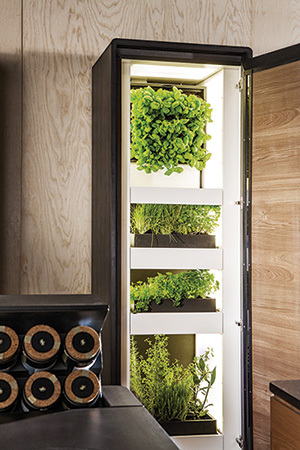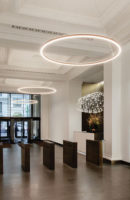These days, kitchen systems are taking a bolder approach to combining materials, marrying a variety of surface treatments in statement-making proportions. In the past, diverse options— such as a metal panel inset in a wooden doorframe—only served as accents. Now, contrasting materials can comprise an entire door or drawer front.
Exemplifying the mix-it-up trend is Alno’s Attract kitchen, which pairs distressed oak with black-glass panels and bronzed-metal drawers. Doimo Cucine’s SoHo kitchen, conceived by Imago Design’s Willy Dalto and Antonella di Nuzzo, blends aged wood, copper, and brass on cabinet runs; it also offers glass doors. And the Miuccia kitchen, by TM Italia, unites rose-copper hardware and stone countertops with lacquered midnight-blue cabinet boxes.
The enhanced palette offers designers an alternative to the “kitchen as antiseptic laboratory” approach, says architect Christopher Rawlins. He continues, “I appreciate the more expansive notion that a kitchen can be as rich, warm, and tactile as one of our bespoke living rooms.”
A Growing Concern

Formquadrat’s concept design for a kitchen that supports vegetarian cooking features an indoor gardening system, a spice-making station, and a bank of ceramic storage containers.
Photo courtesy Formquadrat
Can a kitchen layout change how we eat? Mario Zeppetzauer, a managing director of Austrian industrial-design firm Formquadrat, thinks so. With the Voking kitchen, he says, “We aim to show that design can make vegetarian cooks’ lives easier.” Currently in prototype, the kitchen features seven freestanding units that support the preparation of meat-free meals through specialized appliances, fixtures, and storage areas. The unit, which features active and passive zones, includes a module devoted to spice making—complete with a mortar carved into the counter and a bank of ceramic storage containers. Voking’s double-bowl sink accommodates seed- sprouting trays, while its glass-front cabinets incorporate Urban Cultivator’s indoor gardening system, which allows the user to grow microgreens and herbs.
Although there are no firm plans to produce the Voking, the project’s wide range of backers—including such kitchen, food, and furniture purveyors as Gaggenau, Dornbracht, Team 7, Cosentino, Eisinger Swiss/Franke, and Pfeffersack & Soehne—indicates there is interest in the subject. But Zeppetzauer says the aim is simple: “We want to have a positive impact on the future of nutrition and cooking.” —LC




Post a comment to this article
Report Abusive Comment